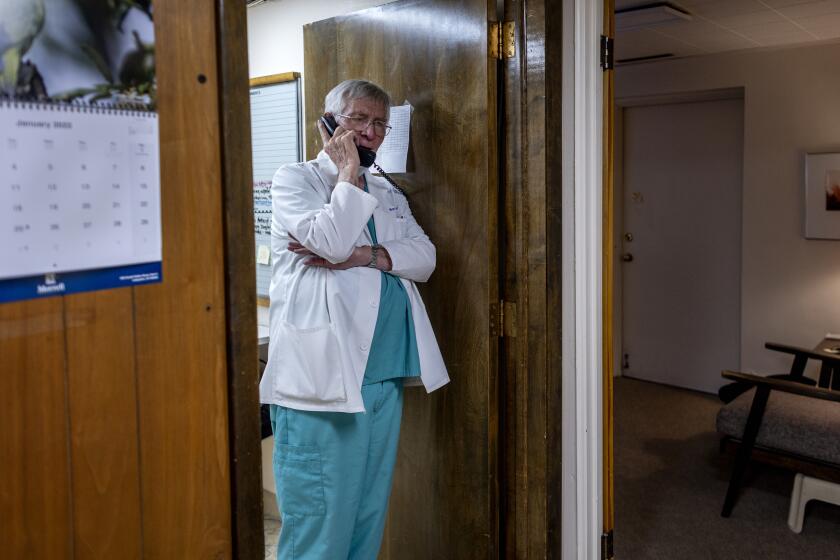Too young for life without parole
In 1646, the General Court of Massachusetts Bay Colony passed the Stubborn Child Law, decreeing that teenage boys who disobeyed their parents could be put to death.
What a difference 3 1/2 centuries make. In our enlightened age, mothers and fathers study manuals for techniques to make children more compliant. And many of us are well acquainted with the critical mass of neuroscience establishing that adolescence constitutes a time of diminished responsibility, when the brain’s frontal lobes — the seat of judgment and impulse control — are still developing.
All too many U.S. criminal courts and state legislatures, however, have yet to get this memo.
Today, according to Human Rights Watch, 2,570 U.S. prisoners convicted of major crimes committed when they were 14 to 17 years old are serving sentences of life without parole. (Some 300 of them are in California.) In recent years, as other industrialized nations have adhered to international human rights conventions, the United States has become the world’s only nation to impose such sentences for minors, say researchers at the University of San Francisco School of Law.
To understand why U.S. courts are doling out such harsh treatment to young lawbreakers, you need to appreciate the Old Testament influences behind the Stubborn Child Law. But it’s also worth considering some recent history: specifically, the panic following the crack-cocaine-fueled crime wave of the 1980s.
Violent juvenile crimes, particularly gang-related assaults, surged in the 1980s and early 1990s, and the reaction verged on hysteria. In 1996, for instance, John J. DiIulio Jr., then a Princeton professor, predicted that 270,000 “radically impulsive, brutally remorseless … juvenile superpredators” would foment even more crime by 2010. Five years later, as juvenile crime plummeted, DiIulio apologized for his hyperbole. Yet the damage had been done, via a legal backlash undermining nearly a century of popular faith in a rehabilitative approach to youthful offenders, originating with the first juvenile court, established in Chicago in 1899.
Most of the draconian laws passed more than a decade ago remain in effect. Today, 29 states, including California, require minors to be tried as adults for major crimes such as murder and some sex offenses, and to face sentences such as life without parole with no opportunity for a judge to intervene.
This is so even as cultural attitudes have been changing because of falling crime rates and the wealth of recent studies demonstrating that brains don’t fully mature until well past adolescence. The evidence clearly shows what most exhausted parents already know: Teenagers often simply can’t imagine the consequences of their actions.
Fortunately, in recent years, theU.S. Supreme Courthas set some cautious limits on punishments for youthful offenders. In 2005, the high court ruled it unconstitutional to impose capital punishment for crimes committed while under the age of 18. In 2009, another Supreme Court ruling banned life sentences without parole for juveniles who committed crimes other than murder.
On Tuesday, the court is scheduled to hear arguments as to whether sentencing a 14-year-old to spend the rest of his or her life in prison, even for murder, violates the Constitution’s ban on cruel and unusual punishment.
Here in California, meanwhile, the Legislature is expected to vote in the coming weeks on a bill by Sen. Leland Yee (D-San Francisco) that would allow reviews of life sentences for all inmates who committed their crimes when they were teenagers. Yee, a child psychologist, calls his bill “an incredibly modest proposal.” Defendants would only be eligible for review after serving 15 years and would at best win the possibility of parole after serving a total of 25.
The two cases up for Supreme Court review are Miller vs. Alabama and Jackson vs. Hobbs. Both defendants are among 73 inmates throughout the United States who have been sentenced to life without parole for crimes committed at the age of 14.
In the first, Evan Miller was convicted, with a 16-year-old friend, of killing a neighbor by beating him and setting his house on fire, while high on drugs and alcohol the man had given them. Miller, the child of alcoholic parents, had been violently beaten by his father for several years, and tried to kill himself six times, beginning at age 5.
In the second case, from Arkansas, Kuntrell Jackson accompanied two older boys as they robbed a video store. When a clerk threatened to call police, one of the older boys shot and killed her.
The attorneys for Miller and Jackson are arguing for leniency mainly on two grounds: First, that young offenders are neurologically less culpable than adults, due to their impulsive tendencies and extra susceptibility to peer pressure, making such sentences cruel; and second, that courts have applied such sentences to children 14 and younger relatively rarely, making them unusual.
Evidence suggests that conditions in prison for juveniles are also exceptionally cruel and unusual. Federal data suggest that as many as half of all victims of inmate sexual abuse are under age 25. Human Rights Watch has found that youth in adult prisons are twice as likely to be beaten by staff and 50% more likely to be attacked with a weapon than minors in juvenile facilities.
Nearly as troublesome is the lost possibility of rehabilitation. One 24-year-old, who had already served nine years for murdering his abusive father, begged for a second chance in a letter to Human Rights Watch. “I would go to the most dangerous parts of Afghanistan or Israel, or jump on the first manned mission to Mars,” he wrote, “if the state were to offer me some opportunity to end my life doing some good, rather than a slow-wasting plague to the world.”
The Supreme Court justices would be wise as well as compassionate to strike a balance: Make juvenile offenders responsible for their actions but don’t completely rob them of hope. And this should apply not only to the inmates who were 14 at the time of their crimes but to the remaining 2,497 who were 15 to 18 years old.
Even the Stubborn Child Law, after all, set a minimum age of 16: the death penalty could only apply to rebelliousness by a son of “sufficient years and understanding.”
Katherine Ellison is the author, most recently, of “Buzz: A Year of Paying Attention,” and writes frequently on adolescence and learning differences. https://www.katherineellison.com
More to Read
A cure for the common opinion
Get thought-provoking perspectives with our weekly newsletter.
You may occasionally receive promotional content from the Los Angeles Times.










